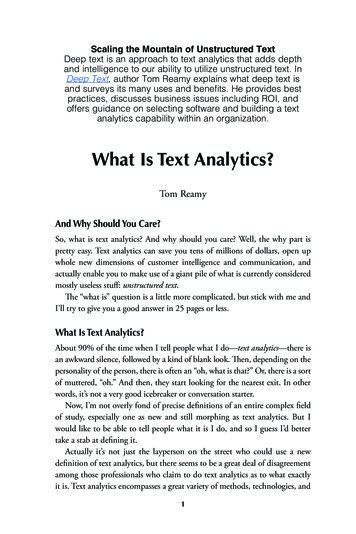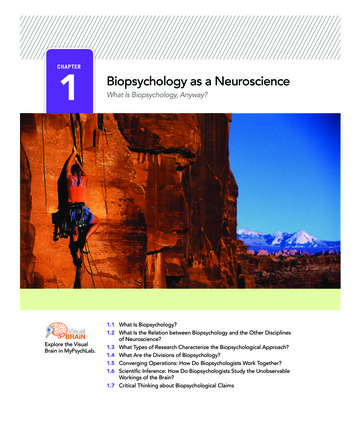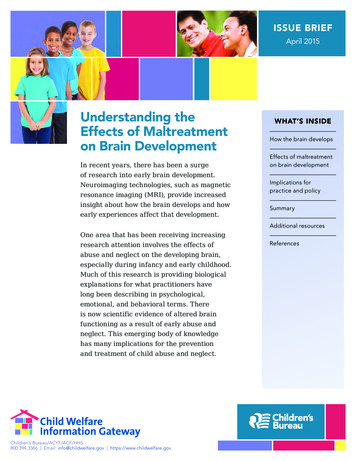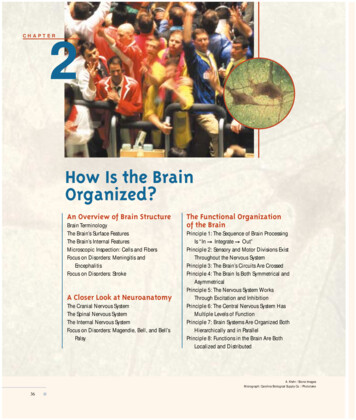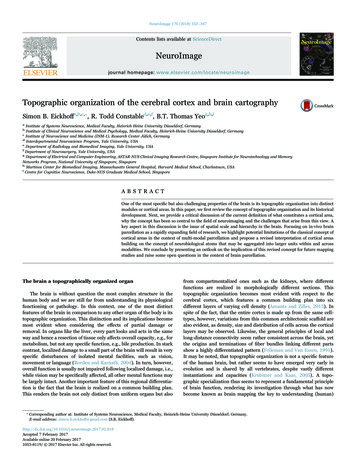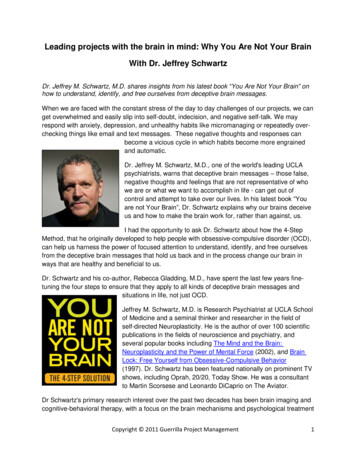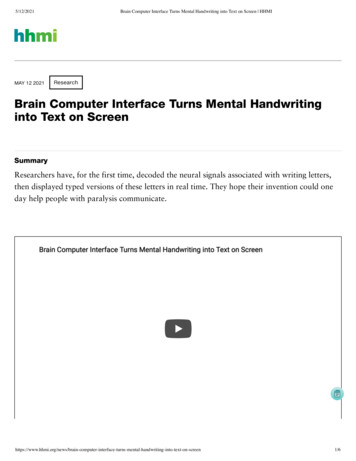
Transcription
5/12/2021Brain Computer Interface Turns Mental Handwriting into Text on Screen HHMIMAY 12 2021ResearchBrain Computer Interface Turns Mental Handwritinginto Text on ScreenSummaryResearchers have, for the first time, decoded the neural signals associated with writing letters,then displayed typed versions of these letters in real time. They hope their invention could oneday help people with paralysis communicate.Brain Computer Interface Turns Mental Handwriting into Text on n1/6
5/12/2021Brain Computer Interface Turns Mental Handwriting into Text on Screen HHMIScientists are exploring a number of ways for people with disabilities to communicate with theirthoughts. The newest and fastest turns back to a vintage means for expressing oneself: handwriting.For the first time, researchers have deciphered the brain activity associated with trying to write lettersby hand. Working with a participant with paralysis who has sensors implanted in his brain, the teamused an algorithm to identify letters as he attempted to write them. Then, the system displayed the texton a screen – in real time.The innovation could, with further development, let people with paralysis rapidly type without usingtheir hands, says study coauthor Krishna Shenoy, a Howard Hughes Medical Institute Investigator atStanford University who jointly supervised the work with Jaimie Henderson, a Stanford neurosurgeon.By attempting handwriting, the study participant typed 90 characters per minute – more than doublethe previous record for typing with such a “brain-computer interface,” Shenoy and his colleaguesreport in the journal Nature on May 12, 2021.This technology and others like it have the potential to help people with all sorts of disabilities, saysJose Carmena, a neural engineer at the University of California, Berkeley, who was not involved in thestudy. Though the findings are preliminary, he says, “it’s a big advancement in the field.”Brain-computer interfaces convert thought into action, Carmena says. “This paper is a perfectexample: the interface decodes the thought of writing and produces the action.”Thought-powered communicationWhen an injury or disease robs a person of the ability to move, the brain’s neural activity for walking,grabbing a cup of coffee, or speaking a sentence remain. Researchers can tap into this activity to helppeople with paralysis or amputations regain lost abilities.The need varies with the nature of the disability. Some people who have lost the use of their hands canstill use a computer with speech recognition and other software. For those who have difficultyspeaking, scientists have been developing other ways to help people -screen2/6
5/12/2021Brain Computer Interface Turns Mental Handwriting into Text on Screen HHMITwo tiny arrays of implanted electrodes relayed information from the brain area that controls the hands and armsto an algorithm, which translated it into letters that appeared on a screen. Credit: F. Willett et al./Nature2021/Erika WoodrumIn recent years, Shenoy’s team has decoded the neural activity associated with speech in the hopes ofreproducing it. They have also devised a way for participants with implanted sensors to use theirthoughts associated with attempted arm movements to move a cursor on a screen. Pointing at andclicking on letters in this way let people type about 40 characters per minute, the previous speedrecord for typing with a brain computer interface (BCI).No one, however, had looked at handwriting. Frank Willett, an HHMI research specialist andneuroscientist in Shenoy’s group, wondered if it might be possible to harness the brain signals evokedby putting pen to paper. “We want to find new ways of letting people communicate faster,” he says. Hewas also motivated by the opportunity to try something different.The team worked with a participant enrolled in a clinical trial called BrainGate2, which is testing thesafety of BCIs that relay information directly from a participant’s brain to a computer. (The trial’sdirector is Leigh Hochberg, a neurologist and neuroscientist at Massachusetts General Hospital, BrownUniversity, and the Providence VA Medical Center.) Henderson implanted two tiny sensors into the partof the brain that controls the hand and arm, making it possible for the person to, for example, move arobotic arm or a cursor on a screen by attempting to move their own paralyzed arm.The participant, who was 65 years old at the time of the research, had a spinal cord injury that left himparalyzed from the neck down. Using signals the sensors picked up from individual neurons when theman imagined writing, a machine learning algorithm recognized the patterns his brain produced /6
5/12/2021Brain Computer Interface Turns Mental Handwriting into Text on Screen HHMIeach letter. With this system, the man could copy sentences and answer questions at a rate similar tothat of someone his age typing on a smartphone.This so-called “Brain-to-Text” BCI is so fast because each letter elicits a highly distinctive activitypattern, making it relatively easy for the algorithm to distinguish one from another, Willett says.A new systemShenoy’s team envisions using attempted handwriting for text entry as part of a more comprehensivesystem that also includes point-and-click navigation, much like that used on current smartphones, andeven attempted speech decoding. “Having those two or three modes and switching between them issomething we naturally do,” he says.As the participant imagined writing a letter or symbol, sensors implanted in hisbrain picked up on patterns of electrical activity, which an algorithm interpretedto trace the path of his imaginary pen. Credit: F. Willett et al./Nature 2021Next, Shenoy says, the team intends to work with a participant who cannot speak, such as someonewith amyotrophic lateral sclerosis, a degenerative neurological disorder that results in the loss ofmovement and speech.The new system could potentially help those suffering from paralysis caused by a number ofconditions, Henderson adds. Those include brain stem stroke, which afflicted Jean-Dominique Bauby,the author of the book The Diving Bell and the Butterfly. “He was able to write this moving and reen4/6
5/12/2021Brain Computer Interface Turns Mental Handwriting into Text on Screen HHMIbook by selecting characters painstakingly, one at a time, using eye movement,” Henderson says.“Imagine what he could have done with Frank’s handwriting interface!”###CitationFrancis R. Willett, Donald T. Avansino, Leigh R. Hochberg, Jaimie M. Henderson, and Krishna V. Shenoy.“High-performance brain-to-text communication via handwriting.” Nature. Published online May 12,2021. doi: 10.1038/s41586-021-03506-2CAUTION: Investigational Device. Limited by Federal law to investigational use.Scientist ProfilesKrishna V. ShenoyStanford UniversityNeuroscience BioengineeringFOR MORE INFORMATIONMeghan Rosen301-215-8859rosenm2@hhmi.orgGET HHMI NEWS BY EMAILSign up Subscribe to RSSRelated LinksThe Shenoy LabHow to “Read” the Brain Signals Underlying Human n5/6
5/12/2021Brain Computer Interface Turns Mental Handwriting into Text on Screen HHMIContact Us / Careers 2021 Howard Hughes Medical Institute / Privacy Policy & Cookie Notice / Terms of Use / Log ce-turns-mental-handwriting-into-text-on-screen6/6
May 12, 2021 · the author of the book . The Diving Bell and the Butterfly. “He was able to write this moving and beautiful . book by selecting char acters painstakingly, one at a time, using eye movement,” Henderson says. . Published online May 12, 2021. doi: 10.1038/s41586-021-03506-2 CAUTIO





